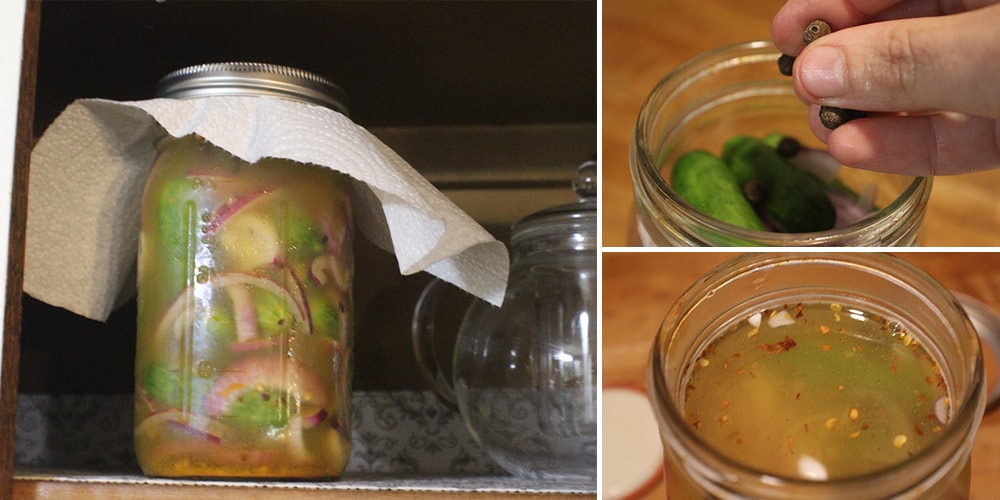
Medicinal Honey Garlic Pickles
Fermented pickles are good for you and have various health benefits, especially when adding other medicinal ingredients to the mix, like raw, unfiltered honey, apple cider vinegar and garlic, as I’ve done with the recipe below. If you’ve never made honey garlic pickles, you’ll be surprised how easy this recipe is.
How The Fermentation is Done
In short, fermentation produces probiotics, which are healthy bacteria. In these quick fermented pickles recipe, the raw, unfiltered honey provides enough microbes for the pickles to ferment in as little as 3-5 days. You’d be lucky to come across these, often called “half-sours,” on store shelves because of their unique preparation method, though you can sometimes find them in specialty food stores.
The yeast and bacteria provided by the natural honey automatically start fermenting once the sugars are diluted. Using honey for fermenting is a fairly reliable method, even for beginners, but it must be RAW and unfiltered honey for it to work.
That reminds me, these pickles aren’t as sweet as you might think they would be, either. The bacteria eat up the glucose in the honey as part of the fermentation process.
This recipe’s 3% salt brine is considered “safe.” One cup of water contains 7 grams of salt. You can use the salt only if you want. The vinegar is unnecessary for the pickling process, but I enjoy the flavor and added medicinal benefits of raw apple cigar vinegar, like helping to control cholesterol and blood sugar. But the health benefits of apple cider vinegar pale in comparison to the benefits of eating ferments.
Fermented Pickle Benefits
Excellent for Gut Symbiosis: A healthy microbiome is essential for the normal functioning of the microbiome, an ecosystem of symbiotic bacteria in the intestines. For that, the right probiotics are necessary. The digestive tract stays healthy as a result of consuming these probiotics, and it might even lessen the risk of colorectal cancer.
Neurodevelopment and a Healthy Mental State: Research indicates that the gut microbiota has a significant effect on neurodevelopment, including the development of the “blood-brain barrier, myelination, neurogenesis, and microglia maturation,” all of which have a direct impact on behavior. Giving the body healthy microorganisms may help the nervous system develop and function, promoting mental wellness. That’s why eating fermented foods can also help reduce anxiety and depression.
Reduces Inflammation and Boosts Immune Response: A diet rich in fermented foods enhances the quantity and diversity of the gut flora and lowers the molecular indicators of inflammation, according to study results released by the Stanford School of Medicine. This recipe also provides additional benefits with the inclusion of turmeric since it lowers inflammation and supports healthy immune responses.
Benefits Skin: The skin contains a microbiome just like our guts do. Studies show probiotics make antimicrobial peptides that strengthen epidermal immune responses and eliminate infections. Through immune system modulation, probiotics provide therapeutic effects for atopic illnesses and positively impact the skin.
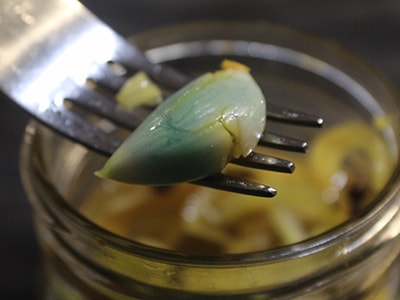 Furthermore, the nutritional benefits of fermented garlic dramatically outweigh that of raw garlic. Fermented garlic is like a super antibiotic that also supports good gut bacteria. It’s also much higher in hydrogen peroxide, eliminating viruses, bacteria, and fungi. And don’t worry if your fermented garlic turns blue. This isn’t mold, and you did nothing wrong. As a matter of fact, blue garlic indicates that the fermentation process was a success.
Furthermore, the nutritional benefits of fermented garlic dramatically outweigh that of raw garlic. Fermented garlic is like a super antibiotic that also supports good gut bacteria. It’s also much higher in hydrogen peroxide, eliminating viruses, bacteria, and fungi. And don’t worry if your fermented garlic turns blue. This isn’t mold, and you did nothing wrong. As a matter of fact, blue garlic indicates that the fermentation process was a success.
Not every single piece will necessarily turn blue; occasionally, the smaller pieces are the ones that this happens to, but not always. Regardless, of whether your garlic becomes blue or stays white, it is normal.
I’ve used just a small assortment of spices, including garlic, turmeric, clove, and red pepper flakes, which are known for their anti-inflammatory and antioxidant effects. However, you are free to use any pickling spices you like, such as dill, celery seed, mustard seed, bay leaves, or coriander. In addition, I used a grape leaf for its tannic acid, which helps keep the pickles crispy. You can also use oak or bay leaves for this.
⇒ Canning Mistakes Even the Most Advanced Homesteaders Make (Video)
Medicinal Honey Garlic Pickles Recipe
Let’s make some pickles!
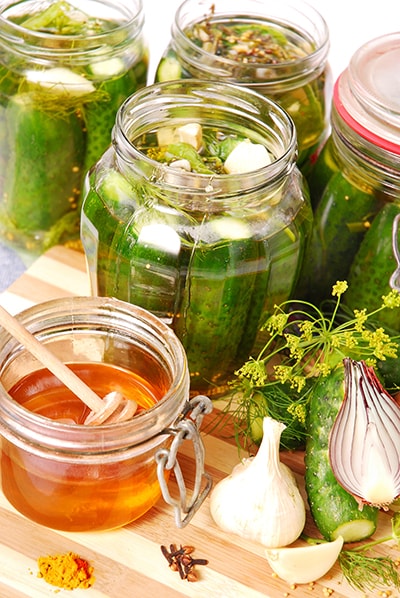
You will need:
- 1 lb. pickling cucumbers (2 – 4 inches in length)
- 1 tbsp mineralized sea salt
- 1 grape leaf
- 5 – 6 cloves of garlic
- 1 tsp whole allspice
- ½ tsp ginger, red pepper flakes, and whole clove
- ¼ tsp turmeric
- 2 tbsp of honey
- half of an onion
- ½ cup apple cider vinegar
- 1 ½ cups filtered water (enough to fill to1 inch below the ring)
- a jar lid and ring
- a fermentation weight or zipper seal bag filled with water
- one quart size jar
Steps
- Firm up cucumbers by putting them in an ice bath for 15 -30 minutes. Removing the blossom end will help them to remain crispy.

- While your cucumbers soak, slice your onion and measure out your spices and set them aside.
- Once your pickles are done, layer them in the jar along with onion and your grape leaf.

- Add your garlic cloves, spices, honey, vinegar, and water.

- Place the lid on along with the ring and shake vigorously to mix.

- Remove the lid from the ring. Now add the fermentation weight or water-filled bag. Make sure all the cucumbers are submerged to prevent mold from growing. Replace the lid with a paper towel or piece of cheesecloth and screw the ring back on.

- Set the jar in a cool dark place, like a kitchen cabinet, for 3- 5 days. You will start to see bubbles forming around day three, which means you have fermentation!

- After three to five days, your half-sour fermented pickles are ready.

These pickles will keep for up to a week in the fridge. They make great little tummy-warming nibbles, but beware—they are highly addicting! And, since they are probiotics, eating too much at once can cause you to use the bathroom more. So, paying attention to your body is important. Otherwise, enjoy!

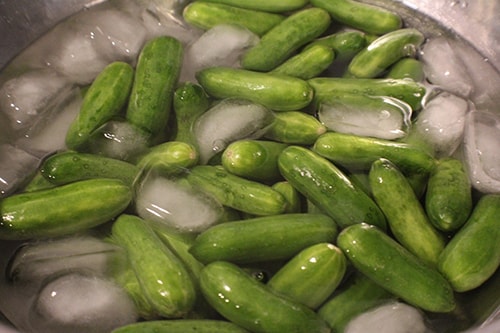
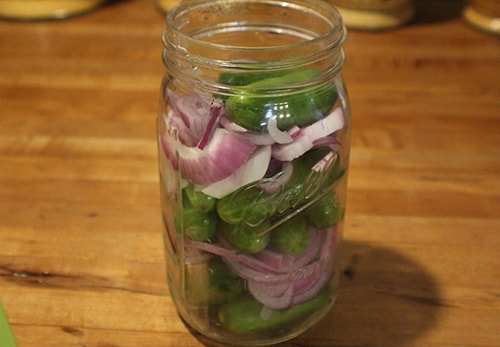

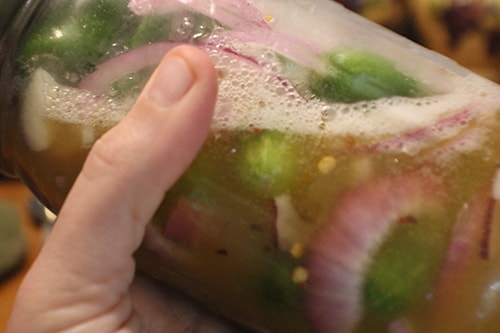
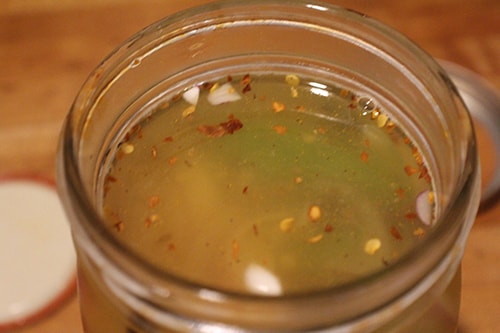
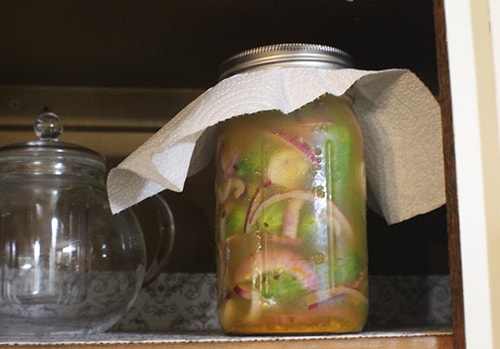
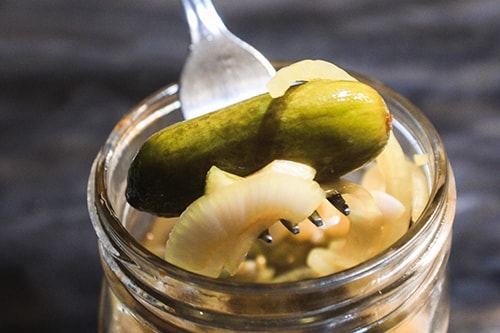
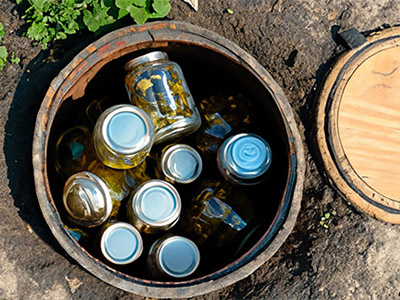
Where do I buy Grape leaves? Are they necessary for this recipe?
Hi Judith,
You can find it at health food stores. They are only necessary if you want a crispy pickle. 🙂 Bay leaves or oak leaves may also be used.
Many blessings and good health!
If only this had been posted when cucumbers were ripe. Will keep this open on my computer along with the violet oil article and wait for next year.
Hi Beth,
Thank you for your interest in this recipe. Let us know how it turns out when you make it.
Many blessings and good health!
I’ve heard in place of grape leaves you can use – I think it was a black tea bag – is that right? Something to do with the tannins & what they do?
And another 2-part question, could you make it without the honey, or replace maple syrup instead of the honey?
Thank you
Hi Sue,
Bay leaves, oak leaves, and, yes, black tea bags may also be used.
Sure, you can replace it with maple syrup, but it won’t have the medicinal properties of the honey.
Many blessings and good health!
Can these pickles be canned in a water bath canner for long term storage or will the heat destroy the good stuff?
Hi Woodreaux,
They can be water-bath canned and taste delicious that way. However, the good bacteria from the ferment will be lost when heated.
Many blessings and good health!